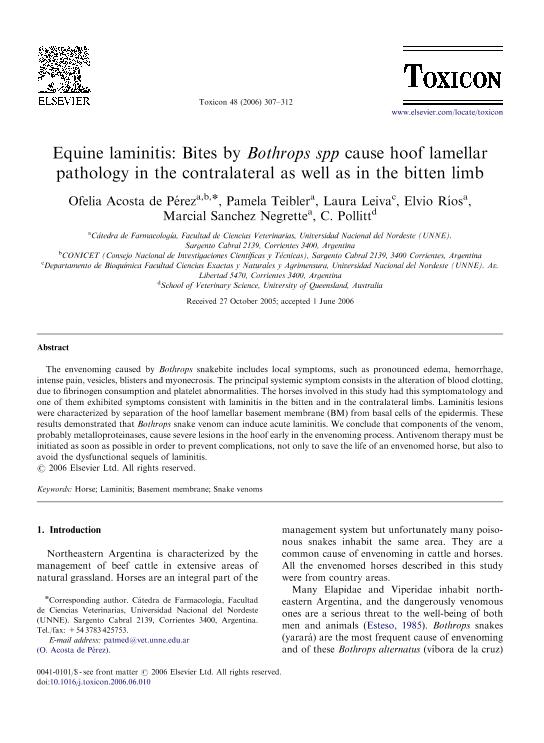Mostrar el registro sencillo del ítem
dc.contributor.author
Acosta, Ofelia Cristina

dc.contributor.author
Teibler, Gladys Pamela

dc.contributor.author
Leiva, Laura Cristina Ana

dc.contributor.author
Rios, Elvio
dc.contributor.author
Sanchez Negrette, Marcial

dc.contributor.author
Pollitt, C.
dc.date.available
2018-06-15T21:43:34Z
dc.date.issued
2006-09
dc.identifier.citation
Acosta, Ofelia Cristina; Teibler, Gladys Pamela; Leiva, Laura Cristina Ana; Rios, Elvio; Sanchez Negrette, Marcial; et al.; Equine laminitis: Bites by Bothrops spp cause hoof lamellar pathology in the contralateral as well as in the bitten limb; Pergamon-Elsevier Science Ltd; Toxicon; 48; 3; 9-2006; 307-312
dc.identifier.issn
0041-0101
dc.identifier.uri
http://hdl.handle.net/11336/48911
dc.description.abstract
The envenoming caused by Bothrops snakebite includes local symptoms, such as pronounced edema, hemorrhage, intense pain, vesicles, blisters and myonecrosis. The principal systemic symptom consists in the alteration of blood clotting, due to fibrinogen consumption and platelet abnormalities. The horses involved in this study had this symptomatology and one of them exhibited symptoms consistent with laminitis in the bitten and in the contralateral limbs. Laminitis lesions were characterized by separation of the hoof lamellar basement membrane (BM) from basal cells of the epidermis. These results demonstrated that Bothrops snake venom can induce acute laminitis. We conclude that components of the venom, probably metalloproteinases, cause severe lesions in the hoof early in the envenoming process. Antivenom therapy must be initiated as soon as possible in order to prevent complications, not only to save the life of an envenomed horse, but also to avoid the dysfunctional sequels of laminitis.
dc.format
application/pdf
dc.language.iso
eng
dc.publisher
Pergamon-Elsevier Science Ltd

dc.rights
info:eu-repo/semantics/openAccess
dc.rights.uri
https://creativecommons.org/licenses/by-nc-sa/2.5/ar/
dc.subject
Basement Membrane
dc.subject
Horse
dc.subject
Laminitis
dc.subject
Snake Venoms
dc.subject.classification
Biología

dc.subject.classification
Ciencias Biológicas

dc.subject.classification
CIENCIAS NATURALES Y EXACTAS

dc.title
Equine laminitis: Bites by Bothrops spp cause hoof lamellar pathology in the contralateral as well as in the bitten limb
dc.type
info:eu-repo/semantics/article
dc.type
info:ar-repo/semantics/artículo
dc.type
info:eu-repo/semantics/publishedVersion
dc.date.updated
2018-06-07T17:55:28Z
dc.identifier.eissn
1879-3150
dc.journal.volume
48
dc.journal.number
3
dc.journal.pagination
307-312
dc.journal.pais
Países Bajos

dc.journal.ciudad
Amsterdam
dc.description.fil
Fil: Acosta, Ofelia Cristina. Universidad Nacional del Nordeste. Facultad de Ciencias Veterinarias; Argentina. Consejo Nacional de Investigaciones Científicas y Técnicas. Centro Científico Tecnológico Conicet - Nordeste; Argentina
dc.description.fil
Fil: Teibler, Gladys Pamela. Universidad Nacional del Nordeste. Facultad de Ciencias Veterinarias; Argentina
dc.description.fil
Fil: Leiva, Laura Cristina Ana. Universidad Nacional del Nordeste. Facultad de Ciencias Exactas Naturales y Agrimensura. Departamento de Bioquímica; Argentina
dc.description.fil
Fil: Rios, Elvio. Universidad Nacional del Nordeste. Facultad de Ciencias Veterinarias; Argentina
dc.description.fil
Fil: Sanchez Negrette, Marcial. Universidad Nacional del Nordeste. Facultad de Ciencias Veterinarias; Argentina
dc.description.fil
Fil: Pollitt, C.. The University Of Queensland; Australia
dc.journal.title
Toxicon

dc.relation.alternativeid
info:eu-repo/semantics/altIdentifier/doi/http://dx.doi.org/10.1016/j.toxicon.2006.06.010
dc.relation.alternativeid
info:eu-repo/semantics/altIdentifier/url/https://www.sciencedirect.com/science/article/pii/S0041010106001991
Archivos asociados
